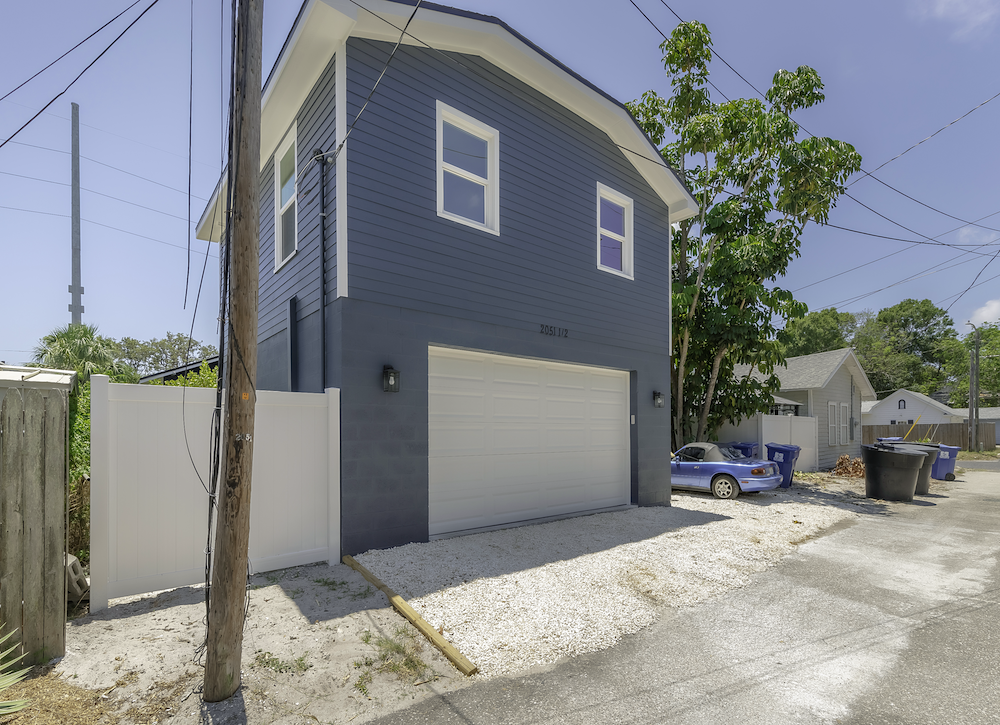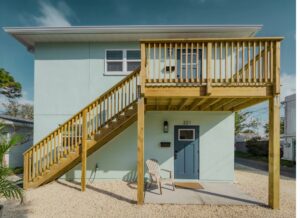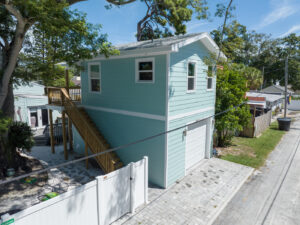As a homeowner, you may have heard about Accessory Dwelling Units (ADUs) and their growing popularity in the world of residential construction. ADUs, also known as tiny homes, granny flats, or backyard cottages, offer a unique and versatile solution for homeowners looking to expand their living space, generate rental income, or accommodate extended family members. In this comprehensive guide, we’ll explore every important aspect of ADUs, from their benefits and types to the legal considerations and construction process.
In this comprehensive guide, our goal is to educate you on every important aspect of Accessory Dwelling Units (ADUs) and how they can transform your living space.
Whether you’re a homeowner looking to expand your living space, or an investor interested in properties amongst the profitable ADU market, this guide will provide you with valuable insights and expert advice.
Table of Contents
What are Accessory Dwelling Units?
Benefits of Tiny Homes
Types of Tiny Homes
Legal Considerations and Zoning Regulations
Building Your Tiny Home: Reviewing Options
Designing Your Tiny Home: Tips and Best Practices
The ADU Construction Process
Financing Your Tiny Home
Exploring the Tiny Home Market: Investment and ROI
What are Accessory Dwelling Units (aka Tiny Homes)
An Accessory Dwelling Unit (ADU) is a secondary living space built on the same property as a primary residence. ADUs can be detached from the main house, attached to it, or built within the existing structure. These compact living spaces include a bedroom, bathroom, kitchen, and living area, providing all the essential amenities for comfortable living.
ADUs allow homeowners the opportunity to maximize their property’s potential by creating additional living space for various purposes. Whether it’s accommodating extended family members, generating rental income, or creating a private home office, ADUs provide flexibility and versatility in meeting changing housing needs. As a result, they have gained popularity in recent years due to their versatility, affordability, and potential to address housing shortages in urban areas.
Benefits of Tiny Homes
ADUs offer a multitude of benefits that make them an attractive option for homeowners seeking to expand their living space or maximize their property’s potential. They offer a versatile and innovative solution to address various housing needs and challenges.
Benefits to building an ADU on your property include:
- Additional Living Space: ADUs provide extra living space for extended family members, such as aging parents or adult children, allowing them to live close by while maintaining independence and privacy.
- Rental Income: Renting out your ADU can generate additional income to help offset mortgage payments, property taxes, or other expenses. In areas with high rental demand, ADUs can be a lucrative investment.
- Increased Property Value: A well-designed and constructed ADU can increase your property’s value, making it a worthwhile long-term investment.
- Affordability: ADUs are typically more affordable to build than traditional home additions, making them an attractive option for homeowners looking to expand their living space without breaking the bank.
- Sustainability: Smaller living spaces require fewer resources to build and maintain, making ADUs an eco-friendly housing option. Additionally, their compact design encourages efficient use of space and energy.
- Flexibility: ADUs can serve multiple purposes throughout their lifespan, from housing family members to providing rental income or serving as a home office or studio.
- Safety and Protection: ADUs constructed by CASK construction can function as hurricane-rated structures to keep your family safe from inclement weather.
By understanding the benefits of ADUs as a tiny home, homeowners can make informed decisions about incorporating these structures into their properties.
Types of Tiny Homes
When it comes to your tiny home ADU, there are various design and integration options available, each catering to different preferences and property layouts.
Types of Tiny Homes:
- Garage Apartment: Garage apartments are a type of accessory dwelling unit that exists on top of a garage as a separate living space. It typically involves transforming the garage area into a self-contained apartment.
- In-Law Suites: A mother-in-law suite is a name frequently used to refer to a single-story ADU. With its convenient layout and easy accessibility, a single-story ADU maximizes comfort and convenience for all occupants.
- Attached ADU: An attached ADU is built as an extension of the main house. This type of ADU shares at least one wall with the primary residence, allowing for convenience and easy access to the main dwelling while maintaining privacy and independence. Attached ADUs can be built as an additional floor or an expanded wing. These tiny homes are an excellent option for homeowners looking to maximize their existing space while creating a separate living area.
- She Shed/Man Cave: A man cave or she shed is a dedicated space within a home or property that provides individuals with a personal retreat, allowing them to pursue hobbies, relax, or engage in activities that reflect their personal interests and style. When built as an individual living space, if the structure does not have a kitchen, it becomes an Accessory Living Quarter rather than an Accessory Dwelling Unit.
- Pool House: A pool house serves as a functional and versatile space adjacent to a pool area. A pool house often does not have the full amenities necessary for independent living, emphasizing its purpose as an accessory to the main property. When a pool house is constructed as a separate living space without a kitchen, it is typically classified as an Accessory Living Quarter rather than an Accessory Dwelling Unit.
The main difference between an ADU (Accessory Dwelling Unit) and an ALQ (Additional Living Quarters) lies in their functionality. While an ADU is a self-contained living space that can be rented out or used as a separate dwelling unit, an ALQ is an accessory building within the main property that lacks kitchen facilities and cannot be utilized as an independent living unit. Homeowners should keep this in mind when thinking about which type of ADU would best fit their needs.
Legal Considerations and Zoning Regulations
Before proceeding with an ADU project, it is essential to familiarize yourself with the specific regulations and legal requirements that govern ADUs in this region.
In St. Pete and surrounding areas, ADUs are permitted in certain zoning districts, and they must meet specific size and requirements. The zoning laws for building an ADU in this area vary depending on the specific location of your property.
Don’t let this step in the ADU process overwhelm you. At CASK Construction, we specialize in designing and building custom ADUs that meet all city requirements and fit your unique needs and preferences.
If you have any questions about local zoning laws, regulations or permitting, we’re one call away! Our construction process helps you every step of the way walking you through the following:
- Zoning and Building Codes: In St. Pete and neighboring areas, ADUs are subject to zoning regulations that define where ADUs are permitted and the specific requirements for their construction. These regulations may include considerations such as minimum lot size, setbacks, and design guidelines. Additionally, building codes outline the technical requirements for construction, covering aspects such as structural integrity, safety standards, and utility connections. As expert ADU home builders, we will let you know the zoning regulations and building codes applicable to your property to ensure compliance.
- Permitting and Approval Process: Obtaining the necessary permits and approvals is a crucial step in ADU construction. In St. Pete and surrounding areas, we will submit the architectural plans, engineering documents, and other relevant information to your local government authorities. The specific process and requirements may vary, and as an ADU expert, we will help you navigate the permitting process and ensure compliance with local regulations.
- Occupancy and Rental Restrictions: Some areas in St. Pete and neighboring jurisdictions may have occupancy restrictions that limit the number of occupants in an ADU. We’ll let you know about these regulations to ensure compliance. Additionally, there may be specific rules regarding rental restrictions, including limitations on short-term rentals or requirements for long-term leases. We’ll educate you with these regulations to understand your options and obligations for renting out your ADU.
- Utility Connections and Impact Fees: In St. Pete and the surrounding areas, we will help you establish utility services for the connection to your ADU. This may involve separate utility connections or shared connections with the primary residence, depending on local regulations.
- Legal Rental Agreements: If you plan to rent out your ADU in St. Pete or nearby areas, it is crucial to have a well-drafted and legally compliant rental agreement in place. We’ll help you consult with legal professionals or real estate experts familiar with local landlord-tenant laws to ensure your rental agreement meets all necessary requirements and protects your rights as a landlord.
By familiarizing yourself with the specific regulations and legal requirements in St. Pete and the surrounding areas, you can ensure compliance, avoid potential issues, and navigate the legal landscape smoothly throughout your ADU project.
Building Your Tiny Home: Reviewing Options
There are different approaches when it comes to creating tiny homes: custom ADU builds, converting existing interior spaces, and using tiny home kits. Each method has its advantages and considerations.
- Custom ADU Builds: Building a custom ADU involves building a separate structure on the property to serve as the ADU. This approach provides the most flexibility in terms of design, layout, and customization. Here are some key points to consider:
Advantages:
- Customization: Building from scratch allows for complete design freedom to create a tailored living space that meets specific requirements and preferences.
- Full Integration: ADUs built from the ground up can seamlessly blend with the existing property, complementing its architectural style.
- Building Codes: Constructing a new ADU ensures compliance with current building codes and regulations from the start.
Considerations:
- Cost: Building from the ground up can be more expensive compared to other methods due to factors like land preparation, construction materials, and labor costs.
- Time: The construction process may take longer compared to other methods, as it involves various stages such as site preparation, obtaining permits, and actual construction.
- Converting Existing Interior Spaces: Converting existing interior spaces involves repurposing parts of the primary residence, such as basements, garage apartments, attics, or spare rooms, to create an ADU. Here are some key points to consider:
Advantages:
- Cost-Effective: Converting existing interior spaces can be more cost-effective than building from scratch, as it utilizes the structure already in place.
- Time: Conversions often require less time compared to ground-up construction since the existing space is already available.
- Integration: Interior ADUs seamlessly integrate with the main residence, allowing for easy access and shared utilities.
Considerations:
- Space Limitations: The size and layout of the existing space may impose limitations on the size and design of the ADU.
- Zoning and Regulations: Check local zoning regulations and building codes to ensure compliance and any specific requirements for interior ADUs.
- Structural Modifications: Some conversions may require structural modifications to meet safety and building code requirements.
- Tiny Home Kits: Tiny home kits provide prefabricated or modular components that can be assembled on-site to create a complete ADU. Here are some key points to consider:
Advantages:
- Convenience: Tiny home kits provide a convenient and streamlined process with pre-designed components that can be quickly assembled.
- Cost: Kits can offer cost savings compared to ground-up construction, as they often come with pre-determined pricing and reduced labor costs.
- Design Options: Tiny home kits offer various design options and floor plans to choose from, providing flexibility within the pre-designed framework.
Considerations:
- Customization Limitations: While there are design options available, customization choices may be more limited compared to building from scratch.
- Liveable Condition Limitations: Tiny home kits often come with only the bare basics that you will then have to paint, reinforce, stain, finish, and insulate yourself. Generally, these structures are not protected from weather or damage before they get to you, and lack major necessities that habitable dwellings require, such as large cavities for insulation, foundation, and spaces to run components for electric and water.
- Permits and Codes: Ensure that the selected kit complies with local building codes and regulations, as well as obtaining necessary permits.
- Skill and Labor: Depending on the complexity of the kit, some construction skills may be required, or professional assistance may be needed for assembly and installation.
Choosing the most suitable approach depends on factors such as budget, timeline, design preferences, available space, and local regulations. It’s crucial to consult with local ADU home building experts to determine the best approach for your specific needs and circumstances.
Designing Your Tiny Home: Tips and Best Practices
Designing your tiny home is an exciting process that allows you to create a functional and comfortable living space that meets your specific needs. It’s the first step where you can begin to envision the cherished memories to be had, or the freedom it can provide your next stage of life. Here is where we turn that vision into reality
Tiny Home Design Tips:
- Define Your Goals and Needs: Start by clearly defining your goals and needs for the ADU. Consider the intended use of the space—is it for accommodating guests, providing rental income, or housing a family member? Understanding your specific requirements will help guide the design process and ensure that the ADU meets your expectations.
- Optimize Space and Functionality: ADUs are typically smaller than primary residences, so maximizing space and functionality is crucial. Emphasize efficiency in the layout and design to make the most of the available square footage. Consider multifunctional furniture, built-in storage solutions, and flexible living areas that can adapt to different uses throughout the day.
- Ensure Privacy and Separate Living Areas: If your ADU will be occupied by different individuals or families, prioritize privacy and create separate living areas. This can be achieved through the strategic placement of walls, doors, or even outdoor spaces to create distinct zones within the ADU.
- Prioritize Natural Light and Ventilation: Integrate ample windows, skylights, or light wells to maximize natural light within the ADU. Natural light not only enhances the aesthetics of the space but also contributes to a sense of openness and well-being. Additionally, consider proper ventilation to ensure a comfortable and healthy living environment.
- Embrace Open Concept Design: Open concept layouts can make small spaces feel more spacious and inviting. By eliminating unnecessary walls and barriers, you can create a sense of flow and connectivity between different areas of the ADU. However, ensure that there is still sufficient privacy and functionality in the design.
- Consider Universal Design Principles: Incorporating universal design principles into your ADU ensures accessibility and inclusivity for individuals of all ages and abilities. Features such as wider doorways, level entrances, grab bars, and non-slip flooring can enhance safety and ease of use for everyone.
- Pay Attention to Storage: Storage is often a challenge in smaller living spaces. Explore creative storage solutions such as built-in cabinets, under-stair storage, loft areas, or hidden storage compartments to optimize space and keep the ADU organized.
- Harmonize with the Existing Property: Whether your ADU is an addition or separate structure, strive for a design that complements the architectural style of the primary residence. A harmonious integration with the main property enhances visual appeal and maintains the overall aesthetics of the site.
- Energy Efficiency and Sustainability: Incorporate energy-efficient design elements into your ADU to minimize environmental impact and reduce utility costs. Consider features such as insulation, energy-efficient appliances, LED lighting, and sustainable materials to create a greener and more sustainable living space.
Work with an ADU home build expert who can provide valuable expertise and guidance throughout the design process. Our team at CASK Construction can help translate your vision into a practical and functional design while ensuring compliance with local building codes and regulations.
The ADU Construction Process
Every contractor will have their own construction process more or less defined. At CASK Construction, we believe in building trust with our customers through open communication and a commitment to excellence. That’s why we provide a detailed, step-by-step process for ADU construction, including:
Step-By-Step Tiny Home Construction Process
- Consultation: We’ll discuss your ADU vision and determine the best approach for your project. We’ll also explain the city requirements and obtain the necessary permits and approvals for your project.
- Design & Planning: Our team will create a customized design that meets your unique needs and preferences while adhering to city requirements. We’ll provide you with drawings of the design, so you can see exactly what your ADU will look like before construction begins.
- Construction: Our team will build your ADU with attention to detail and a focus on quality. We’ll keep you updated on the progress of the project and address any questions or concerns you have along the way.
- Completion: We’ll conduct a final walkthrough with you to ensure your satisfaction with the finished product. We also offer a one-year warranty on our workmanship, so you can have peace of mind knowing your ADU is built to last.
One thing that separates CASK construction from other ADU contractors is our pre-construction agreement. For those qualified to have an ADU built and are seriously considering an ADU, we offer a small contract that includes:
- Drawings of your project
- Specifications
- Allowances
- Budget (surpasses a free estimate)
- Architecture
- Design
We guarantee that if you don’t feel comfortable moving forward at any point during this pre-construction process, we do not need to continue on to the next step which is building you’re a ADU
Financing Your Tiny Home
If you’re considering an ADU project but are unsure about the financial aspect, rest assured that we have you covered. At CASK Construction, we understand the importance of accessible financing options to bring your ADU dreams to life. We work closely with reputable lenders who are committed to making the financing process as seamless and straightforward as possible.
Tiny Home Financing Options
- Cash: Paying for your ADU project with cash offers the advantage of avoiding interest rates and monthly loan payments. If you have saved up enough funds, this can be a viable option to finance your project outright.
- Personal Loan: A personal loan is an unsecured loan that can be used for various purposes, including financing your ADU. Personal loans typically have fixed interest rates and repayment terms, providing flexibility and convenience for homeowners.
- Home Equity Line of Credit (HELOC): If you have equity built up in your home, a HELOC can be an excellent option for financing your ADU. A HELOC allows you to borrow against the equity in your home, providing a flexible line of credit that can be accessed as needed. Interest rates on HELOCs are often lower than other forms of credit, making it an attractive option for homeowners.
- Home Improvement Loan: Specifically designed for home improvement projects, a home improvement loan can be used to finance your ADU construction or renovation. These loans typically have favorable terms and interest rates, making them an accessible option for homeowners.
- Homestyle Renovation Loan: The Homestyle Renovation Loan is a mortgage option that allows you to finance both the purchase or refinance of your home and the cost of renovating or building your ADU. This loan combines the financing into one, simplifying the process and providing funds for your ADU project.
- Construction Loan: If you are constructing an ADU from the ground up, a construction loan may be suitable for your needs. This type of loan provides funds to cover the costs of construction, and once the ADU is completed, it can be refinanced into a traditional mortgage or paid off with other financing options.
These payment options provide you with the flexibility and freedom to choose the financing method that aligns with your financial goals and circumstances. We recommend consulting with our knowledgeable team or a trusted financial advisor to assess which option best suits your needs.
Exploring the Tiny Home Market: Investment and ROI
Investing in a tiny home in St. Pete can offer not only a unique and versatile living space but also potential financial benefits. The tiny home market in St. Pete is thriving, and many homeowners are discovering the opportunities it presents.
Rental Opportunities: The city’s vibrant lifestyle, favorable climate, and proximity to stunning beaches attract residents, tourists, and individuals seeking a more sustainable and minimalist way of living. This increasing demand translates into a robust market for tiny homes.
As a popular tourist destination, St. Pete attracts a steady stream of visitors throughout the year. Many tourists seek unique and affordable accommodations, and tiny homes perfectly fit this niche. By renting out your tiny home, whether as a short-term vacation rental or a long-term lease, you can generate a consistent income stream and potentially offset the costs associated with your investment.
Additionally, tiny homes generally require less maintenance compared to traditional houses, translating into lower expenses for homeowners. With fewer square footage and simplified systems, maintenance tasks, repairs, and utility costs are typically reduced. This advantage contributes to a higher ROI, as a significant portion of the rental income can be directed towards profit or further investment.
In the St. Petersburg area, an ADU can generate approximately $35,000 in gross annual income.
Increased Property Value: The real estate market in St. Pete has shown a positive trend in terms of property appreciation. As the demand for housing continues to grow, property values have been steadily increasing. Several studies show homes with ADUs typically sell for a higher price compared to those without one. In America’s biggest cities, a home with an ADU is priced 35% higher on average than a home without one. By investing in a tiny home in St. Pete, you have the potential to benefit from property appreciation over time, enhancing the overall return on your investment.
CASK Construction – St. Pete’s Top ADU Builder
As a homeowner, you’ve made a significant investment in your property, and it’s only natural to want to maximize its potential. At CASK Construction, we understand your desire to create a space that serves your family’s needs while enhancing your property’s value.
Using an ADU as your tiny home offers a unique and versatile solution to achieve your goals. Tiny homes can create a comfortable and functional living space for extended family members, generate additional rental income, and increase your home’s overall value. Our team at CASK Construction is committed to helping you navigate the ADU construction process, from design to build, ensuring your project is a success.
As a local St. Pete, Florida-based company, we pride ourselves on our expertise in ADU projects and our familiarity with local building codes and regulations. Our professional, friendly, and approachable team is dedicated to providing quality workmanship and exceptional customer service, making your ADU project an enjoyable and rewarding experience.
Let CASK Construction help you unleash the potential of tiny homes and transform your property into a versatile, functional, and valuable living space that you and your family can be proud of. Contact us today to discuss your ADU project and discover how we can bring your vision to life.






